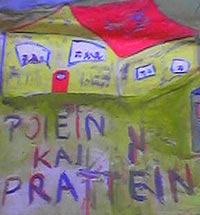Comments on the workshop 1: 'Culture and Economy'
byAnna Arvanitaki (regional planner/architect: Athens, Greece)
1. European integration vis-à-vis cultural policy: areas of conflict between national policies and European integration laws (i.e. Article 92 of TEU).
2. The new industrial paradigm (at a macro level): the global-local interplay in corporate strategies: from mass production to diversification and differentiation of production to meet "specifically" based demand, from vertical integration to disintegration of production (small decentralised units) to exploit economies of scope (instead of economies of scale), from hierarchical structures (within the firm) to co-operative structures; a move towards 'Toyotism'.
Question:
The move towards more co-operative (more 'collusive' behaviour) forms of organisation
in the economy can be attributed to...."cultural
backgrounds", or is dictated by the needs of the economic system itself which has reached
its limitations in its former Fordist type of organisation? Why the latter
has worked perfectly for so many years in so many countries of the Western
world?
The idea that "branch-plant" economy
doesn't work efficiently (metropolis in the desert) has prompted:
a) the companies to change method of "intruding" specific
markets (i.e. the European) and instead of setting up branches in backward
regions to take over existing companies in the area, so as to take over the
area "from the inside", which means to capitalise on the local "embedded ness" of the existing firm.
b) Governments to stop "injecting" investments
to specific regions from the outside and try to support locally originated
initiatives instead.
But because local initiatives - in most cases - are not enough, regions, cities and whole (small) countries are found to compete with one another for the attraction of external investment in the context of an increasingly flexible capital which seeks to take advantage of local specificities in terms of labour markets, business 'milieu', good environments, favourable political cultures etc..
Conclusion: Companies are interested to "exploit" local
specifities in terms of (amongst other things) culture.
2.a the notion of "Economic Anchorage"
Reference was made to vertical disintegration of production, namely the location separation of the head-offices of firms from real production units: a very well known element of the new model of industrial organisation (see above).
Given this, what is the discussion about?
In the text, (indirect) recommendation is made that governments should focus
on firms (units) being located in their area (according to the above mentioned
policy) and not necessarily nationally owned.
Key question: How this combines with the need to pursue as much control as possible of the economic structure by the respective local (national or regional etc.) society / government?
2.b local development
The paper of Frank Moulaert summarises this as having to do with two main
points:
- The socio-cultural characteristics of a region / locality play a role as
a development potential;
- other local development models should be conceived, which put emphasis on
the local population (needs, traditional skills, potentialities for retraining,
entrepreneurial capacity etc.) vis-à-vis the traditional focus of development
strategies upon local economic structures (how to develop the "export
base" etc.)
2.c models of industrial organisation at a micro-level: with a firm
Models of organisation of firms are compared:
- Within Europe (i.e. "Germany" vis-à-vis
the "British" model)
- Between Europe, USA and Japan
Conclusion: recommendation is made (to managers?) that a universal model should not be imposed, but cultural differences in terms of co-operative or individualistic attitudes etc. should be taken into account.
Question: What comes as a necessity from the restructuring needs of capital, namely to move from more to less hierarchical forms of organisation, should be open to local bargaining and modification?
2.c how firms respond to cultural diversity
Do they impose - a naturally defined - culture from above or do they try
more synergistic models?
Recommendation is made that (multinational) firms should be clever enough not
to provoke ethnocentric reactions of the work force, but try to capitalise
on cultural differences by improving productivity.
2.c what should be the qualities of an international manager
Repeats the points of 2
« 3. Comments on the Workshops of the Fourth Seminar, “Culture, Building Stone for Europe 2002” | Comments on workshop 3: 'Culture and Identity' »
